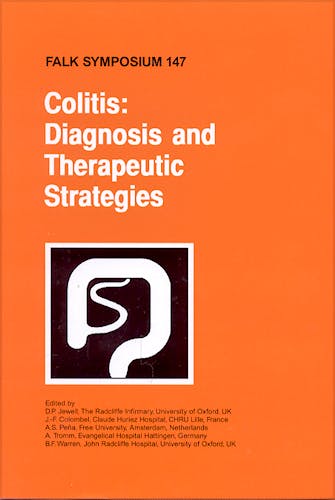

No hay productos en el carrito



Colitis: Diagnosis and Therapeutic Strategies
Falk Simposium
1ª Edición Abril 2006
Inglés
Tapa dura
265 pags
600 gr
16 x 24 x 2 cm
ISBN 9781402043154
Editorial SPRINGER
About this book
Ulcerative colitis and Crohn’s disease remain a major challenge within gastroenterology. Their aetiology remains unknown and provides a major intellectual challenge, although much progress is being made in understanding the influence of gene mutation on susceptibility to disease and on the course and behaviour of that disease. Diagnostic methods have improved and the advent of colonoscopy, with the ability to take multiple biopsy specimens, has not only widened our diagnostic vision but has allowed the detection of dysplasia. Surveillance colonoscopy has been introduced as a result and continues to stir up controversy. Treatment, having remained static for almost 50 years, has become enormously exciting, with many new avenues being explored. It has been informed by progress in our understanding of disease pathogenesis and, as such, is highly stimulating and provides an excellent paradigm for treating disorders of unknown aetiology.
The book, the proceedings of Falk Symposium 147 on ‘Colitis: Diagnosis and Therapeutic Strategies’, held in Birmingham, UK, May 6–7, 2005, provides an update for any gastroenterologist, medical or surgical, with an interest in inflammatory bowel disease. Clinically important aspects of diagnosis and treatment are covered but underpinned by scientific mechanisms. It is an exciting book which looks into the future as well as informing current practice.
Written for:
Clinicians, researchers, graduate students, academics
Table of contents
- List of principal contributors. List of chairpersons. Preface.
- SECTION I: DIAGNOSIS. 1 Role of capsule encoscopy in Crohn's disease. 2 Endoscopy in Crohn's disease. 3 Colitis diagnosis and therapeutic strategies - how, what and when to biopsy.
- SECTION II: MICROSCOPIC COLITIS. 4 Epidemiology of microscopic colitis. 5 Microscopic colitis: histological classification. 6 Mechanisms of pathogenesis in microscopic colitis. 7 Microscopic colitis: treatment.
- SECTION III: PREDICTING OUTCOMES. 8 Predicting the natural history of inflammatory bowel disease. 9 Who gets extra-intestinal manifestations? 10 Colitis: predicting outcomes -- who gets cancer?.
- SECTION IV: CORTICOSTEROID THERAPY. 11 Mechanisms of steroid action and resistance in inflammatory bowel disease. 12 Budesonide for ulcerative colitis. 13 How do I use steroids in Crohn's disease? 14 Why corticosteroids should not be used as first-line therapy for Crohn's disease.
- SECTION V: AZATHIOPRINE. 15 Azathioprine: molecular mechanism of action. 16 Pharmacogenetics of azathioprine - useful in clinical practice? 17 Azathioprine: long-term side-effects. 18 State-of-the-Art Lecture: Trials and complications of ileal pouch surgery.
- SECTION VI: IMMUNOMODULATORY THERAPY. 19 Biologics in ulcerative colitis.
- SECTION VII: CANCER AND IBD. 20 Diagnosis of colitis associated dysplasia: new colonoscopic techniques. 21 Can we prevent cancer using current drugs? 22 Management of low-grade dysplasia in inflammatory bowel disease. 23 Low-grade dysplasia in flat mucosa: is it relevant?.
- SECTION VIII: NEW THERAPEUTIC APPROACHES. 24 Leucocytapheresis. 25 Helminths and immune.- modulation of inflammatory bowel disease. 26 Probiotics for inflammatory bowel disease.-
- Index
© 2025 Axón Librería S.L.
2.149.0